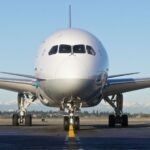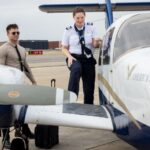A Discussion on Temperature
By Steven Daun, National Chief Pilot
Winter is here and with it comes significant variation in the weather. It is important to note that when we discuss “winter weather” we are not just speaking about it being cold outside. Winter weather encompasses many different topics. For this article, we are going to focus on temperature. Rather than looking at temperature as just how cold it is outside, we need to consider the current temperature as well as the temperature range that come before and after the current weather. Is it getting warmer or colder along our route of flight? Do we have standard or close to standard temperature at our altitudes, or do we have an inversion? If it rains or if there is moisture in the air, what conditions can we expect? Most importantly, what effect will the temperature have on my airplane and me?
How do we know if it is getting warmer or colder along our route of flight?
As with any flight, you should begin with a standard weather briefing from Flight Service. Yes, call Flight Service for your weather briefing. When you speak with a briefer they will not only review your route of flight and weather with you, but they will also discuss and provide you some education based on their background and experience. This information is at times more important than the briefing and you will miss out on their knowledge if you try to self-brief the weather. Using Post-it notes or writing the enroute temperatures directly on your chart could be an easy way to compare what is forecasted versus actual. Once enroute you should remain in contact with flight service for weather and temperature updates along your route of flight.
How do we determine standard temperature along our route of flight?
Standard temperature is defined as 15°C (59°F) at sea level. Standard temperature decreases by 2°C for every 1,000 feet of altitude. Based on the weather briefing you receive, you should calculate what your standard temperature should be at key points in your flight. Then compare your estimate to actual. This will enable you to identify significant changes in the weather before they become a surprise. You should also use this time to determine if there are any temperature inversions along your route. Yes, sometimes we do have to climb to get to warmer temperatures.
What is the effect of temperature when there is moisture in the air?
There are several effects. The most simple and easiest to understand is that water freezes at 32°F regardless of whether it is in or on your aircraft.
While it may seem obvious, it is still important to discuss the effects of air moisture as they pertain to temperature. Having a clear understanding of this interaction will enable you to determine things such as icing susceptibility, hail, freezing rain, visibility and runway conditions at airports along your route and at your destination. Once you have gone through this process, ideally you should develop contingency plans to deal with each situation.
If the air moisture remains constant and the temperature drops, the relative humidity will increase. Likewise, if the moisture remains constant and the temperature increases, your relative humidity will decrease. Why is all of this important? When air rises, it cools. At some altitude the air temperature will equal the dew point, which means that the air will be fully saturated. If the air mass continues to rise, condensation will occur. This is accompanied by a release of latent heat into the rising air, which results in slower cooling as the air mass continues to rise. This phenomenon is what is represented in the adiabatic lapse rate.
When we consider the stability of an air mass, we need to take into consideration the temperature and the temperature of the air surrounding the area. If the temperature at our current position is cooler than that of the surrounding air mass, then the air is more dense and will sink. This means that we will have stable air resulting in a smooth ride for our flight. Conversely, if the
temperature at our current position is warmer than that of the surrounding air mass, the air is less dense and will rise. As we know from our student pilot days, rising air is unstable air. We will have better visibility but a much bumpier ride.It is imperative that when flying with outside air temperatures lower than 32°F, you understand the moisture level of the air that you are in as well as the air above and below your position.
What effect will temperature have on my airplane?
Oil – If we look at the Cessna 172R POH, it tells us that if we operate in temperatuhave gone through thisres below 12°C (10°F), we need to use 30 or 20W-30 oil. However, the POH also tells us that we can use 15W-50 or 20W-50 for all temperatures. Contrary to popular belief, the “W” does not stand for weight, the “W” stands for “winter.” This means that the oil has a specific maximum flow or viscosity at low temperatures. In other words, the lower the “W”number the better performance we will get out of the oil in cold temperatures and when starting the engine in colder temperatures.
Fuel – 100LL or Avgas will freeze at -58°C (-72°F). While the majority of light GA aircraft and pilots will not fly in these conditions, some will fly an aircraft that uses 100LL and has a pressurization system. In this case you should be aware of this. The concern is not necessarily the condition of fuel in your tanks but the fuel in your fuel lines. You may be asking why we are discussing freezing fuel if we are not going to be flying anywhere near these conditions. It is because there are many aircraft in use today with diesel engines. These aircraft use jet fuel that can begin to freeze at -43°C (-45°F). Regardless of which type of aircraft you fly, you want to ensure that any and all water has been removed from the fuel tanks during your preflight inspection. Remember, it is highly unlikely that your fuel will freeze, but if there is water in your fuel, it could begin to freeze at 0°C (32°F).
Engine – Many aircraft will have specific instructions on starting an aircraft during low temperatures. The POH for the Cessna 172R, as an example, states that if temperatures are below -6°C (20°F), it is recommended that an external engine preheater and external power source are used. This is done to reduce wear on the electrical system and to ensure that any congealed oil in the oil cooler will thaw prior to engine start. Many aircraft like the Cessna 172R have available winterization kits. You should find out if the aircraft that you are flying has a winterization kit installed, so you will understand what the effects of that kit are on your engine. If you do have a winterization kit installed on your aircraft, you also need to understand the limitations. An example would be taking off in the Northeast when it is 5°F with a winterization kit installed. Your destination is Florida where it is 80°F. The limitation on the winterization kit says that it should not be used at temperatures over 20°F. Do you remove it before your flight? Do you remove it enroute? You can speak with your mechanic to make the proper decision.
If you are flying an aircraft that has a carburetor, you will need to be alert to the susceptibility of carburetor ice. This goes hand in hand with the earlier discussion in this column on the moisture content of the air that you are flying through.
Electrical wires and plastic connectors – Cold weather can also affect your electrical wires and plastic connectors. When preflighting an aircraft in extremely cold conditions, you should take care not to flex or move any wires or connectors. Extremely cold temperatures can make these brittle and weak to the point where they can easily break.
What effect will temperature have on me?
The last major consideration is the effect of temperature on you and your passengers. Are you prepared to deal with a scenario in which your cabin heater stops working? It may be a good idea to have a spare sweater or two on board for each person, especially if there is a good distance between airports. Does the heater in your aircraft use fuel and a combustion chamber? If so, do you have a carbon monoxide detector in your aircraft? What actions will you take if you detect carbon monoxide in your cabin?
When body temperature falls below 97.7°F we run the risk of entering the early stages of hypothermia. The first sign that hypothermia is setting in is that we begin to shiver. Your heart rate and blood pressure will begin to rise. If ignored, your mental judgment and decision-making ability will become effected. You will then enter the moderate stages of hypothermia when the
shaking becomes more violent and your motor skills start to slow down. This is when fingernails and lips begin to turn blue (do not mix this up with carbon monoxide poisoning). If your body temperature falls below 86°F, you risk falling into the severe stages of hypothermia where you could become incapacitated and even at risk for death. If you are aware of the signs and
you take the appropriate steps necessary to prepare contingency plans, you will be fine.
Some of the best flying in the world is during the wintertime. From bare trees to snow-covered mountains, the views are endless and intoxicating. When fully prepared, winter flying is quite safe and pleasurable for both pilot and passengers. However, flying in very cold weather becomes dangerous when you are not aware of your surroundings (meteorologically and geographically) and you do not have ample contingency plans established.










